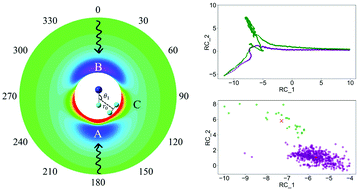Mode-specific dynamics in multichannel reaction NH+ + H2
Abstract
The vibrational- and rotational-mode specificity of the multichannel NH+ + H2 reaction is studied on a recently constructed ab initio-based global potential energy surface using an initial state selected quasi-classical trajectory method, and the trajectories are analyzed using an isometric feature mapping and k-means approach. All excitation modes promote two reactions (R1: NH′+ + H2 → NH+ + HH′ and R4: NH′+ + H2 → NH2+ + H′) where both NH and HH bonds are broken, but reduce the reactivity of the proton-transfer reaction R2 (NH′+ + H2 → N + H′H2+) at low collision energies. For the hydrogen-transfer reaction R3 (NH′+ + H2 → HNH′+ + H), the rotational excitation of NH+ enhances the reactivity remarkably, while its vibrational excitation has an inhibiting effect on the reaction. The trajectory analyses show that the vibrational and rotational excitations of NH+ make R3 tend to go over a submerged saddle point instead of extracting hydrogen atoms directly. On the other hand, the motions of the H2 reactant facilitate the enhancement of the reactivity but they do not affect the mechanism of R3. In addition, the results suggest that the coupling of the isometric feature mapping and the k-means approach in the trajectory analysis is an appropriate tool for reaction-dynamics studies.



 Please wait while we load your content...
Please wait while we load your content...